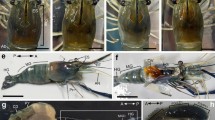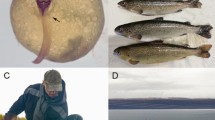Abstract
Most pandalid shrimps show protandric hermaphroditism, and male sexual differentiation is considered to be controlled by the androgenic gland. In the present study, we examined the histology of gonadal development during the male phase and sex change and the involvement of the androgenic gland in regulating male reproduction in laboratory-maintained Pandalus hypsinotus. Juvenile shrimps developed testicular tissues in the peripheral part of gonads during the age of 16–31 months and produced spermatozoa between 34 and 36 months. After reaching sexual maturity, male shrimps exhibited seasonal testicular development: active production of spermatozoa (February–May), disappearance of spermatozoa (spent, April–June), increase of spermatocytes (May–November), appearance of spermatids and spermatozoa in the gonads (November–February). The androgenic gland cells became larger and the rough endoplasmic reticulum in the cytoplasm developed at male sexual maturity. The cell structure shows that the androgenic gland hormone is a peptide. Furthermore, bilateral eyestalk ablation on immature male shrimps induced hypertrophy of the androgenic gland and acceleration of male sexual maturation. These results indicate the involvement of androgenic gland hormone and some eyestalk factor in regulating male sexual maturation. Over a 1-year laboratory-rearing period, some male shrimps (16.7%) changed sex. In transitional shrimps, testicular tissues in the gonads and androgenic glands degenerated; on the other hand, oocytes started yolk protein accumulation and hemolymph vitellogenin levels became high. These results suggest that androgenic gland degeneration is a trigger for sex change and that the vitellogenin level is a useful marker for sex change.













Similar content being viewed by others
References
Adiyodi RG (1984) Seasonal changes and the role of eyestalks in the activity of the androgenic gland of the crab, Paratelphusa hydrodromous (Herbst). Comp Physiol Ecol 9:427–431
Allen JA (1959) On the biology of Pandalus borealis Krøyer, with reference to a population off the Northumberland coast. J Mar Biol Assoc UK 38:189–220
Aoto T (1952) Sexual phases in the prawn, Pandalus kessleri Czerniavski, with special reference to the reversal of sex. J Fac Sci Hokkaido Univ Ser 6 Zool 11:1–20
Aoto T, Nishida H (1956) Effects of removal of the eyestalks on the growth and maturation of the oocytes in a hermaphroditic prawn, Pandalus kessleri. J Fac Sci Hokkaido Univ Ser 6 Zool 12:412–424
Baldwin AP, Bauer RT (2003) Growth, survivorship, life-span, and sex change in the hermaphroditic shrimp Lysmata wurdemanni (Decapoda: Caridea: Hippolytidae). Mar Biol 143:157–166
Bauer RT, Holt GJ (1998) Simultaneous hermaphroditism in the marine shrimp Lysmata wurdemanni (Caridea: Hippolytidae): an undescribed sexual system in the decapod Crustacea. Mar Biol 132:223–235
Bergström BI (2000) The biology of Pandalus. In: Southward AJ, Tyler PA, Young CM, Fuiman LF (eds) Advances in marine biology, vol 38. Academic, London, pp 55–245
Carlisle DB (1959a) On the sexual biology of Pandalus borealis (Crustacea Decapoda): I. Histology of incretory elements. J Mar Biol Assoc UK 38:381–394
Carlisle DB (1959b) On the sexual biology of Pandalus borealis (Crustacea Decapoda): II. The termination of the male phase. J Mar Biol Assoc UK 38:481–491
Carlisle DB (1959c) On the sexual biology of Pandalus borealis (Crustacea Decapoda): III. The initiation of the female phase. J Mar Biol Assoc UK 38:493–506
Carpenter MB, De Roos R (1970) Seasonal morphology and histology of the androgenic gland of the crayfish, Orconectes nais. Gen Comp Endocrinol 15:143–157
Charniaux-Cotton H, Payen G (1985) Sexual differentiation. In: Bliss DE, Mantel LH (eds) The biology of Crustacea, vol 9. Academic, New York, pp 217–299
Foulks NB, Hoffman DL (1974) The effects of eyestalk ablation and β-ecdysone on RNA synthesis in the androgenic glands of the protandric shrimp, Pandalus platyceros Brandt. Gen Comp Endocrinol 22:439–447
Hoffman DL (1968) Seasonal eyestalk inhibition on the androgenic glands of a protandric shrimp. Nature 218:170–172
Hoffman DL (1969) The development of the androgenic glands of a protandric shrimp. Biol Bull 137:286–296
Hoffman DL (1972) The development of the ovotestis and copulatory organs in a population of protandric shrimp, Pandalus platyceros Brandt from Lopez Sound, Washington. Biol Bull 142:251–270
Katakura Y (1989) Endocrine and genetic control of sex differentiation in the Malacostracan Crustacea. Invertebr Reprod Dev 16:177–182
Keller R (1992) Crustacean neuropeptides: structures, functions and comparative aspects. Experientia 48:439–448
Khalaila I, Katz T, Abdu U, Yehezkel G, Sagi A (2001) Effects of implantation of hypertrophied androgenic glands on sexual characters and physiology of the reproductive system in the female red claw crayfish, Cherax quadricarinatus. Gen Comp Endocrinol 121:242–249
Khalaila I, Manor R, Weil S, Granot Y, Keller R, Sagi A (2002) The eyestalk–androgenic gland–testis endocrine axis in the crayfish Cherax quadricarinatus. Gen Comp Endocrinol 127:147–156
Kim DH, Jo Q, Kim BK, Han CH (2002) Eyestalk ablation-induced androgenic gland activity and gonad development in the freshwater prawn Macrobrachium nipponense (De Haan, 1849). Invertebr Reprod Dev 42:35–42
King DS (1964) Fine structure of the androgenic gland of the crab, Pachygrapsus crassipes. Gen Comp Endocrinol 4:533–544
Kurata H (1957) The biology of the prawn, Pandalus hypsinotus. Mon Rep Hokkaido Fish Exp Stn 14(2):42–51
Manor R, Aflalo ED, Segall C, Weil S, Azulay D, Ventura T, Sagi A (2004) Androgenic gland implantation promotes growth and inhibits vitellogenesis in Cherax quadricarinatus females held in individual compartments. Invertebr Reprod Dev 45:151–159
Martin G, Sorokine O, Moniatte M, Bulet P, Hetru C, Van Dorsselaer A (1999) The structure of a glycosylated protein hormone responsible for sex determination in the isopod, Armadillidium vulgare. Eur J Biochem 262:727–736
Murakami K (1986) Brood stock and hatchery of the coonstriped shrimp Pandalus hypsinotus. Saibaigiken 15:27–41(in Japanese)
Murakami K (1992) Maturity cycle, and copulation and spawning behavior of rearing Pandalus hypsinotus. Saibaigiken 20:65–72(in Japanese)
Nagamine C, Knight AW (1987) Masculinization of female crayfish, Procambarus clarkii (Girard). Invertebr Reprod Dev 11:77–86
Nagamine C, Knight AW, Maggenti A, Paxman G (1980a) Effects of androgenic gland ablation on male primary and secondary sexual characteristics in the Malaysian prawn, Macrobrachium rosenbergii (de Man) (Decapoda, Palaemonidae), with first evidence of induced feminization in a nonhermaphroditic Decapod. Gen Comp Endocrinol 41:423–441
Nagamine C, Knight AW, Maggenti A, Paxman G (1980b) Masculinization of female Macrobrachium rosenbergii (de Man) (Decapoda, Palaemonidae) by androgenic gland implantation. Gen Comp Endocrinol 41:442–457
Okumura T, Hara M (2004) Androgenic gland cell structure and spermatogenesis during the molt cycle and correlation to morphotypic differentiation in the giant freshwater prawn, Macrobrachium rosenbergii. Zool Sci 21:621–628
Okumura T, Hara M, Hara M, Okiyama M (1997) Possible roles of the androgenic gland in male reproduction in the giant freshwater prawn, Macrobrachium rosenbergii. In: Kawashima S, Kikuyama S (eds) Advances in comparative endocrinology, vol 1. Monduzzi Editore, Bologna, pp 73–77
Okumura T, Yoshida K, Nikaido H (2004) Ovarian development and hemolymph vitellogenin levels in laboratory-maintained protandric shrimp, Pandalus hypsinotus: measurement by a newly developed time-resolved fluoroimmunoassay (TR-FIA). Zool Sci 21:1037–1047
Okuno A, Hasegawa Y, Ohira T, Katakura Y, Nagasawa H (1999) Characterization and cDNA cloning of androgenic gland hormone of the terrestrial isopod Armadillidium vulgare. Biochem Biophys Res Commun 264:419–423
Sagi A, Khalaila I (2001) The crustacean androgen: a hormone in an isopod and androgenic activity in decapods. Am Zool 41:477–484
Sagi A, Manor R, Segall C, Davis C, Khalaila I (2002) On intersexuality in the crayfish Cherax quadricarinatus: an inducible sexual plasticity model. Invertebr Reprod Dev 41:27–33
Taketomi Y (1986) Ultrastructure of the androgenic gland of the crayfish, Procambarus clarkii. Cell Biol Int Rep 10:131–136
Taketomi Y, Nishikawa S (1996) Implantation of androgenic glands into immature female crayfish, Procambarus clarkii, with masculinization of sexual characteristics. J Crust Biol 16:232-239
Taketomi Y, Murata M, Imakado K (1996) On the androgenic gland of the crayfish, Procambarus clarkii: I. Seasonal changes in the cell structure of the androgenic gland of the crayfish, Procambarus clarkii. Mem Fac Gen Edu Kumamoto Univ Nat Sci 31:65–72
Zupo V (2000) Effect of microalgal food on the sex reversal of Hippolyte inermis (Crustacea: Decapoda). Mar Ecol Prog Ser 201:251–259
Zupo V (2001) Influence of diet on sex differentiation of Hippolyte inermis Leach (Decapoda: Natantia) in the field. Hydrobiologia 449:131–140
Acknowledgements
The present study was supported, in part, by a Fisheries Research Agency project, and by funds from the Cooperative Program No. 38, 2001 provided by Ocean Research Institute, University of Tokyo. The experiments comply with the current laws of Japan.
Author information
Authors and Affiliations
Corresponding author
Additional information
Communicated by T. Ikeda, Hakodate
Rights and permissions
About this article
Cite this article
Okumura, T., Nikaido, H., Yoshida, K. et al. Changes in gonadal development, androgenic gland cell structure, and hemolymph vitellogenin levels during male phase and sex change in laboratory-maintained protandric shrimp, Pandalus hypsinotus (Crustacea: Caridea: Pandalidae). Marine Biology 148, 347–361 (2005). https://doi.org/10.1007/s00227-005-0073-7
Received:
Accepted:
Published:
Issue Date:
DOI: https://doi.org/10.1007/s00227-005-0073-7




